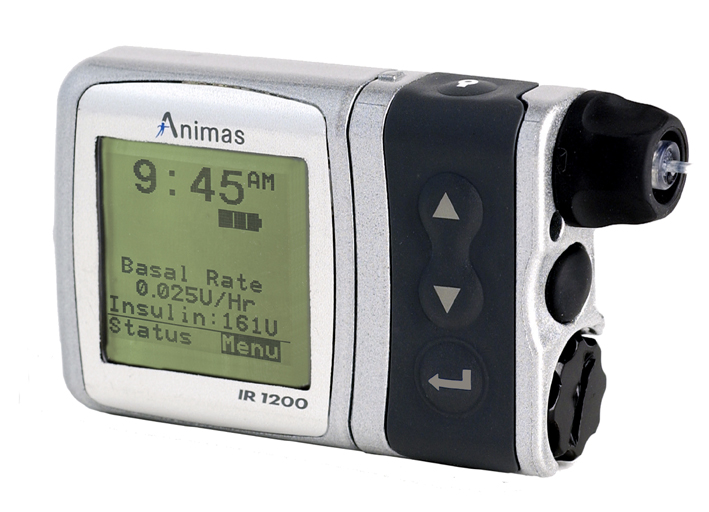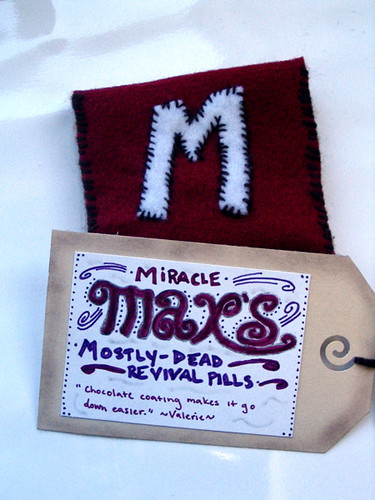I often times (quietly, in my head) compare my insulin pump to
AAC devices and not just because I relate to a cyborg identity (prosthetic pancreas, prosthetic speech).

 (obviously the scale between these two items is not quite right, but I deliberately choose to show an older pump, the one I use, and an older AAC device - because we can't all get to have the newest and the fanciest. Of course if I really wanted to demonstrate the obsoleteness of my pump I would have shown a ChatPC original, not a ChatPC 3. )
(obviously the scale between these two items is not quite right, but I deliberately choose to show an older pump, the one I use, and an older AAC device - because we can't all get to have the newest and the fanciest. Of course if I really wanted to demonstrate the obsoleteness of my pump I would have shown a ChatPC original, not a ChatPC 3. )Insulin pumps are small devices that recreate, to some extent, the insulin producing part of a pancreas (a pancreas does more than produce insulin). Insulin pumps deliver a constant flow of insulin, just like a pancreas, and the wearer pushes some buttons to deliver a burst of insulin when carbohydrates are eaten, just like a pancreas (well minus the button pushing). However the wearer still needs to take their blood glucose level (commonly known as blood sugar) six to eight times a day (by sticking themselves with a needle to produce a drop of blood to put into a glucose meter) and then enter the number on the meter into the pump.
My insulin pump is vital to my life. I, could, technically, live without, if I were to return to a world of five injections a day, carrying syringes and vials or a pen-
esque device and little needle caps to go on it and revolving my life around a schedule of injections and carbohydrate consumption. People's
AAC devices are vital to their lives. They could, technically, live without them, if they were to return to manual communication books, a life of only being able to say yes/no and a limited world.
Much like
AAC devices there are many flavors (i.e. vendors and models) of insulin pumps. Much like
AAC devices some models are top of the line, with well researched engineering, an intuitive design and amazing customer service while other models are copycats, with sloppy engineering and customer service that is practically non-existent.
Much like
AAC devices there are issues with proving a potential user is "worthy" (will be able to use and benefit from the device according to whatever professional gets to make that call - it took me three endocrinologists before one would write me a script for a pump) and many, many issues with funding.
Also, much like
AAC devices, insulin pumps have come a long way. (To use my first pump I had to carry a number of charts and a calculator to figure out the math and know how much insulin to give at any time, now my pump does all that for me. My first pump was also much larger than the one I have now. However, my pump is obsolete, it is no longer sold and the newer models do so much more than what mine does, from coming in colors and just being cooler looking, to playing music instead of noisy alarms, to being smaller and having an integrated carbohydrate glossary listing thousands of foods and the number of carbohydrates in them,
eliminating the need to carry a
carb-counting book. Also newer pumps can get an add-on feature that
continuously monitors blood glucose and beams that number to the pump, meaning less sticking of yourself with needles. Yet, because of insurance and funding issues I cannot get a new pump and live in fear of my pump failing because it is out of warranty. The first
AAC devices I knew were huge, impossible to carry/mount and did one thing only, "speak".)
Why am I telling you all this? Because some things are going on in the insulin pump world that I fear could happen in the
AAC world. For example, because of the economy, low sales and high costs one insulin pump maker has
announced it is stopping production. This company is in the top tier of pump makers, maybe not the
Dynavox or PRC of pump companies, but still well known for its use of standard features, durability and customer service. It was also popular with the kids because it looked kind of cool.
What will be lost because of this, I think, is innovation within the market, not to mention many users who will have to switch to a different company and jobs. Insulin pumps are expensive and the more features you get/need the more expensive they are. Just like
AAC devices are expensive and the more features you get/need the more expensive they are.
People, including me, complain about the cost of their pumps. People argue that they should not cost so much, that the actual value of the little plastic box, the piston inside and the electronics is very, very small compared to what we pay for them. We forget about the years and years of research and innovation that went into it. We forget about the fact that the need for these devices is actually very small and thus the parts to manufacture them are more expensive. We forget about exactly how specialized they are. We forget about the team of researchers, community based customer representatives and the customer support people on the phone/online who need to be paid and have benefits. We forget about the cost of marketing, without which the devices would not survive. We forget that to stay in business these companies must be innovating all the time.
Sure, some people can go with the less expensive device (pump or
AAC) because they want/need (usually need) less features. If you don't need
continuous glucose monitoring or highly sensitive alarms when your pump malfunctions or compatibility between your pump and your monitor you can buy a cheaper pump. If you don't need scanning or a
keyguard or Morse code access or tech support you can get a cheaper
AAC device.
It might be time, given this economy and the risk of loosing some great devices (pumps,
AAC and more) for cyborgs to unite. We need to remember the true cost of not having our cyborg parts to ourselves and our worlds. We need to remind ourselves why our cyborg parts cost so much. We need to fight for research and development. We need to remind the world including our elected officials, our doctors, our insurance companies (public and private) and everyone else we can think of that we would be lesser people if it weren't for our cyborg parts and that is a cost saving measure none of us should be willing to take.
I am sort of imagining a campaign like the Windows campaign (you know, "I'm a PC and I am four and half"), except "I'm a cyborg, I pump insulin (or
bacoflen or
immunoglobin)", "I'm a cyborg, my heart is keeps it's
rhythm with a pacemaker", "I'm a cyborg, I breathe with a ventilator", "I'm a cyborg, I speak with an
AAC device". "Cyborg and proud!"
P.S. Obviously I am not ACTUALLY a cyborg. Please don't mistake my humor with that belief. Nor do I believe that other people who use medical devices/prosthetics are cyborgs. Nor do I think cyborg is any kind of insult. I am seriously proud to be a cyborg. I bask in the glow of my cyborg-ness (or that might just be the glow of my pumps backlighting).
P.P.S. For you fellow diabetics and those who love diabetics (I don't want to hear one word about person first language here. I'm a diabetic and I get to self label as I wish.) I received my latest Hemoglobin A1c in the mail today. 5.7. Feel free to congratulate me.



























